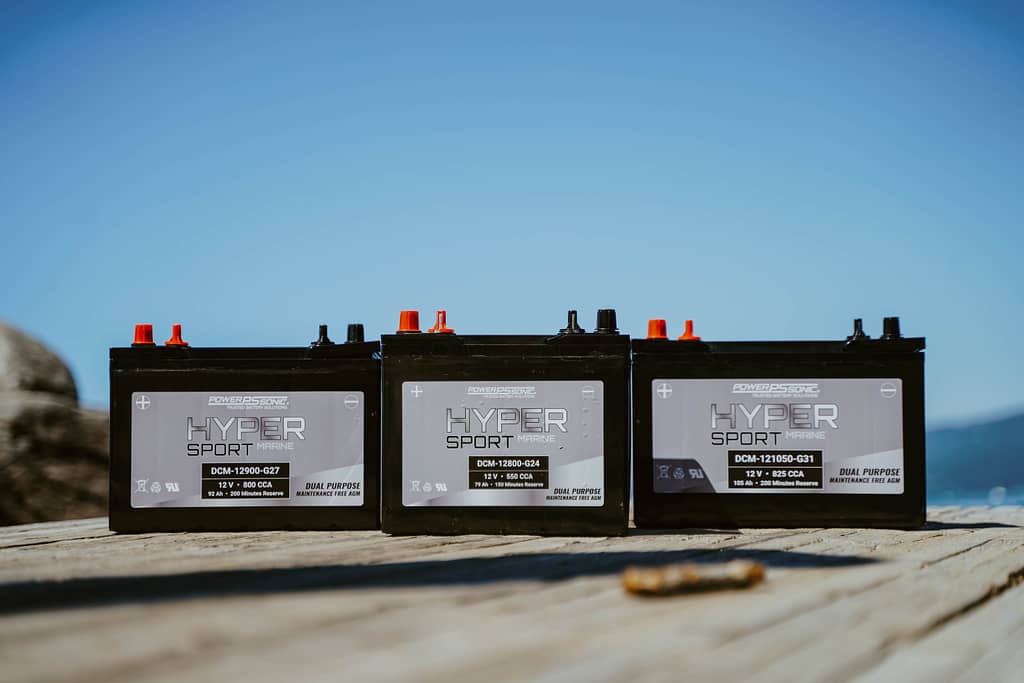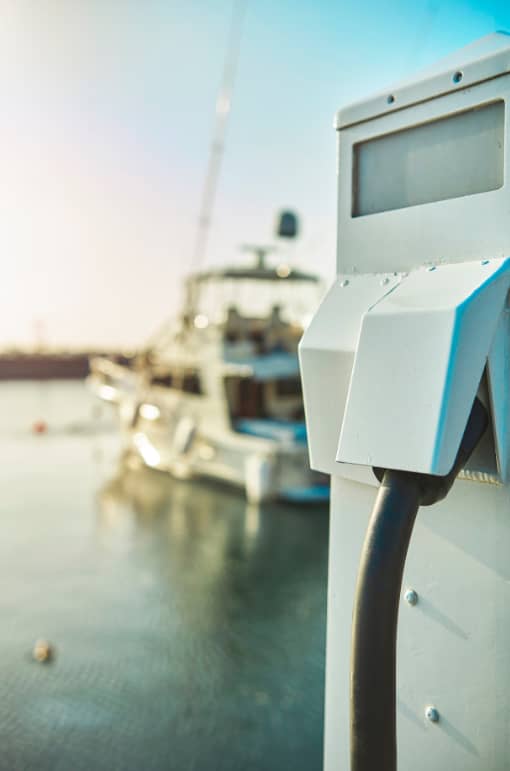Marine battery charging is a crucial aspect of ensuring a seamless and worry-free boating experience. In this comprehensive guide, we explore the world of marine battery chargers, discussing the different types, their applications, and how to ensure compatibility with your marine battery. We recommend reading our marine blog, which covers the basics of marine batteries, as prelude to diving into marine battery charging.

What are the types of marine battery chargers?
Onboard and portable marine chargers are the two types of boat charges. Many boaters opt for one or the other, depending on their boating habits. Some may even choose to have both if they find it necessary to have a backup power source or need flexibility for various scenarios. Ultimately, the choice between onboard and portable chargers is a personal one, and it depends on factors such as the type of boating, frequency of use, and budget.
Onboard Marine Battery Chargers
Onboard marine chargers are permanently installed on the boat and are connected directly to the boat’s electrical system. These chargers offer the advantage of automatic charging, as they continuously monitor the battery’s condition and adjust the charging rate accordingly. Onboard chargers are recommended if you primarily use your boat near shore power sources or marinas, as it eliminates the need to carry and connect a portable charger each time.
Methods of Onboard charging include:
Shore Power Charging: When your boat is docked at a marina or connected to an external power source, shore power charging is the most common and convenient method. A shore power connection allows you to charge your batteries using a battery charger specifically designed for marine use.
Offshore Charging: Unlike shore power charging, which relies on a direct connection to the electrical grid at a marina, offshore marine charging involves the use of onboard generators or alternative power generation methods to charge the boat’s batteries. To enhance the sustainability and self-sufficiency of offshore charging, integrating solar power systems has become increasingly popular. This method is essential for long-distance and extended voyages, as it allows boats to remain self-sufficient and powered even when away from the mainland.
Alternator Charging: While on the water, the boat’s engine alternator can also charge the batteries. The alternator generates electrical power when the engine is running, directing it to charge the starting battery and, if connected, the deep cycle battery as well. However, keep in mind that the alternator is primarily designed to maintain the starting battery’s charge, so it may not provide a complete deep cycle battery recharge. Additionally, many alternators are not designed to continuously charge a deeply discharged battery, but rather only to maintenance charge a starting battery at low current.

Portable Marine Battery Chargers
Portable marine chargers are compact and versatile, designed to be carried on board or used on land to charge batteries when docked. They come in various models, including manual, automatic, and smart chargers, and are suitable for various battery types.
Portable chargers are preferred in various boating scenarios where flexibility and mobility are crucial. If you are frequently far from shore power or marinas, a portable charger becomes a vital tool, enabling you to recharge your batteries wherever you anchor. Additionally, if you own multiple boats with diverse charging needs or frequently use rental boats, a portable charger offers the convenience of being able to carry a single charger that can adapt to various vessels. Budget-conscious boaters often choose portable chargers for their cost-effectiveness compared to installing onboard systems.
Charger Compatibility
Whether your choice is onboard, portable, or both, your charger must be compatible with your battery. When you have a single battery on your boat, determining the voltage and amperage required for your charger is relatively straightforward. Identify the voltage of your battery, which is typically indicated on the battery itself (e.g., 12 volts for most marine batteries). Your charger should match this voltage. Then, consider the battery’s capacity, measured in ampere-hours (Ah). A charger’s amperage output should ideally be around 10-20% of the battery’s capacity. For instance, if you have a 100Ah battery, a charger with an output of 10-20 amps is suitable.
When you add another battery to your marine system the approach to charging becomes more complicated. Charger compatibility depends on the way the batteries are connected in your electrical system. There are two primary configurations – series and parallel – and the charger requirements differ for each.
When batteries are connected in series, their voltages are added together. For example, if you have two 12-volt batteries in series, the total voltage is 24 volts. In this case, your charger needs to be compatible with the higher voltage. So, if you have a 24-volt battery bank in series, you’ll need a 24-volt charger.
In contrast, when batteries are connected in parallel, the voltage remains the same, but the capacity (amp-hours) is increased. For instance, two 12-volt batteries in parallel will still have a 12-volt output but double the capacity. In this setup, your charger should be capable of handling the combined amperage needs of the parallel-connected batteries. So, if you have two 100Ah batteries in parallel, you’ll need a charger that can effectively charge a 200Ah battery bank. You can learn more about connecting batteries in series and parallel here.

What is the importance of multistage charging?
Smart chargers are an excellent choice for marine use due to their advanced technology and the critical importance of maintaining healthy marine batteries. Both portable and onboard chargers can come with smart charging capabilities. Smart chargers are designed to optimize the charging process, ensuring that marine batteries are charged efficiently and safely.
Unlike traditional chargers, smart chargers employ a multistage charging approach, which involves bulk, absorption, and float stages. This method not only speeds up the charging process but also safeguards the battery’s longevity. It prevents overcharging, a common issue with less sophisticated chargers, by gradually reducing the charging current as the battery nears full capacity. In the challenging marine environment, where reliable power is essential for navigation and onboard electronics, smart chargers are a vital tool to extend battery life and enhance safety, making them a wise investment for any boat owner.
Deep Cycle AGM VS Lithium
Charging a deep cycle AGM marine battery and a lithium marine battery involves differences due to the distinct chemical compositions and characteristics of the two types. Deep cycle marine batteries, typically lead-acid based, require a specific charging regimen. They need a multi-stage charging process, including bulk, absorption, and float stages, to ensure optimal performance and longevity. Overcharging or undercharging can significantly impact their lifespan and efficiency.
On the other hand, lithium marine batteries, which use advanced lithium technology, have a different charging profile. They require a carefully controlled charging process, with built-in battery management systems that prevent overcharging and overheating. Lithium batteries can handle higher charge and discharge rates and offer faster charging times compared to traditional deep cycle batteries.

Charging Tips
Once you have determined the type of charger you need, it is important to understand the best practices for marine charging.
- Avoid Overcharging: Overcharging can damage batteries and significantly reduce their lifespan. Consider using smart chargers that monitor battery conditions and automatically adjust the charging process to prevent overcharging.
- Maintain a Full Charge: Always keep your battery fully charged. Lead acid batteries are prone to sulfation, which occurs when the battery remains at a partially charged state for extended periods. Lithium batteries are not as susceptible to this issue as they have a longer self-life and can endure being partially charged without the same degree of harm.
- Regular Maintenance: Periodically check the battery’s state of charge, electrolyte levels (for flooded batteries), and the condition of terminal connections. Clean terminals if corroded and ensure they are tight.
- Proper Storage: If the boat is not in use for an extended period, consider using a battery maintainer or trickle charger to keep the battery in good condition. Store batteries in a cool, dry place.
- Follow Manufacturer’s Instructions: Always follow the manufacturer’s recommendations and guidelines for charging and maintaining your specific battery type.
Whether you prefer onboard or portable marine battery chargers, the choice depends on your boating habits and needs. Onboard chargers offer convenience, while portable chargers provide versatility. Ensure charger compatibility by matching voltage, capacity, and features with your battery. To maintain battery health, avoid overcharging, conduct regular maintenance, and store the battery correctly. By following these guidelines, you’ll have a reliable power source for your boating adventures.






